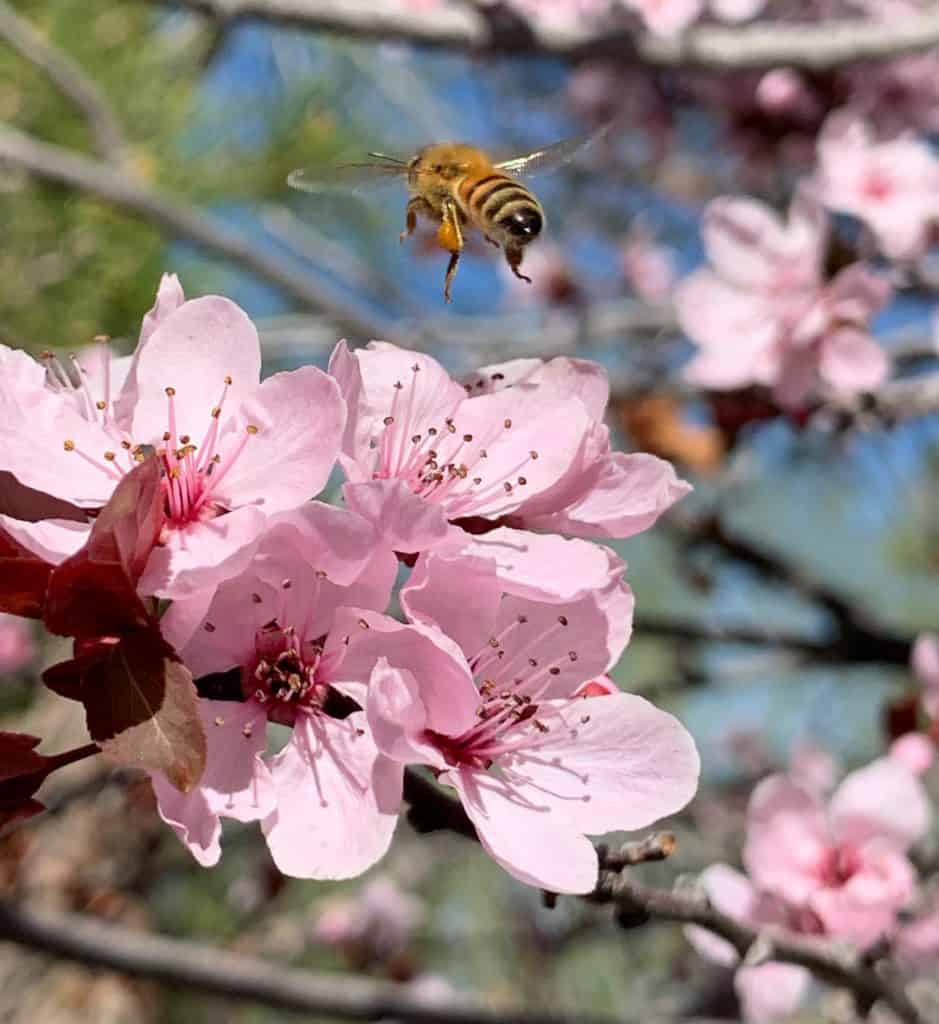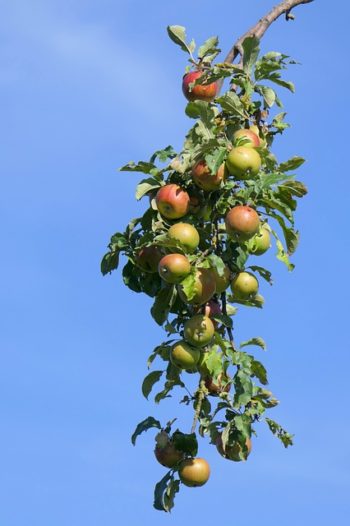There is an age-old technique that will help your fruit trees to yield a more consistent crop from year to year. The technique will also aid in producing a better tasting and dependable crop. The technique is thinning the young fruit.
The technique sounds simple and it is. There are however a few guidelines and tricks that can help with thinning young fruit. For years, I have wanted to aid my fruit trees to bear better fruit and to equalize the heavy producing years with the low producing years. Thinning fruit is an exceptional time-tested method that works great.
Continue reading for tips and techniques for thinning your fruit trees.

(Photo credit Donna Silva)
Why do we need to thin fruit on a tree?
Every spring I get excited to see all the blossoms show up on the fruit trees in my garden orchard. The first to bloom always seems to be the apricot trees. I learned a song when I was young about “looking out the window and what did I see, popcorn popping on the apricot tree”.
It sometimes actually looks like popcorn on the apricot tree. There are so many blossoms clustered thickly together it often appears as though there is one large blossoming branch. This clustering is a mechanism of nature to ensure there are some surviving fruit, so the trees produce more blossoms than needed.
With this overabundance of blossoms comes an overabundance of fruit production. The extra fruit puts a great deal of stress on the fruit tree itself, requiring extensive energy and resources to grow. When the fruit isn’t thinned the tree can become overtaxed, weakened, and susceptible to disease, pests, and sunburn.
The surviving blossoms grow into fruit and compete for resources needed from the tree. If the fruit isn’t thinned, the remaining fruit will get stunted and not grow as well. The size, color, and quality of the fruit will be compromised resulting in a sub-par product.
Fruit that is bunched up and laying on top of each other on the tree can promote diseases. Brown rot is often passed from one fruit to another when touching. Additionally, pests can easily traverse from fruit to fruit and do damage when the fruit is touching.
Have you ever noticed that one year you will get a bumper crop and the next year you get nothing? The bumper crop heavily stresses the tree and it requires a year to recoup.
A plethora of fruit on the tree, (especially near the ends of the branches) will result in branches cracking or breaking. The weakened state of the tree together with the stress of production, as well as the weight of the fruit itself can overburden the branches. I have often propped up limbs with boards and stakes to keep branches from breaking under the weight of fruit. Our Peach and apple trees seem to be especially susceptible to this.
Thinning the fruit on your tree is a good thing
Thinning the fruit at the correct time will aid your crop and tree. With the proper amount of thinning you will greatly reduce the stress on the tree and the fruit will be able to develop to its biggest size and best flavor. Without having to compete for sunlight the fruit will get the best color and look.
Good pruning practices and thinning the fruit will also help regulate the tree. The training of the tree through thinning and pruning will help get the tree to bear fruit every year instead of every alternate year. You can train your tree to actually produce high quality fruit every year.
Good pruning and fruit thinning will also help with the structural strength of the fruit tree. With thinning the fruit. Particularly towards the ends of the branches, it reduces the weight on the tree branches. When the wind blows, and the fruit matures the thinned fruit branches will be able to withstand a lot more wind and the weight of the fruit is not as much an issue.
The thinned fruit tree branches also will allow for air to get around the fruit. The transition of disease and pests are lowered. The fruit will be able to dry out after rain or irrigation and the growth of fungus or mildew will be greatly diminished. The shape of the fruit will also be more optimal and look good.

Nature already thins the fruit to a point.
The blossoms and fruit will naturally thin themselves to a point. Blossoms that are not pollinated will turn yellow and drop off just after flowering early in the season. We have installed beehives into our garden orchard and so many if not all of the blossoms are pollinated resulting in a lot of fruit.
In June, or late spring, many small immature fruits will naturally drop. This drop of immature fruit is often known as the “June drop”. This natural drop will vary depending on your location and geography. For instance, it happens in May in California. I would think that on the other side of the equator it would be more of the November drop.
Sometimes fruit that is diseased will drop. Fruit that is infested with insects may drop. Apples and pears can get infested with codling moths and drop prematurely.
For some types of trees, the natural thinning is all that is needed. Some of the naturally thinning fruit trees are:
- Cherries
- Bartlet Pear
- Persimmons
- Pomegranates
- Nut
- Apricot
Branches of persimmon and apricot trees may need to be thinned on particularly heavy years.
The Specific trees the need thinning
There are species of trees that as a general rule will need thinning of the immature fruit. These include:
Stone Fruit Trees:
- Peach
- Apricot (this can vary from year to year)
- Nectarine
- Cherry (depends on variety and will vary from year to year)
- Plum (depends on variety)
Pome Fruit Trees:
- Apple
- Asian Pear
- Most European Pear
It is often a standard practice to remove all fruit from small young trees. This allows the tree to focus on growth of the tree itself instead of being utilized by the fruit. Once the tree is established then fruit can be allowed to grow, but you will need to use caution and thin the fruit to keep from breaking small weak branches.

When to thin the fruit.
Timing is important when thinning fruit. You need to thin the fruit when they are immature and small. This is typically from early to mid-spring. In the United States generally from early April for early-ripening fruit like apricots, and up to mid-May for late-ripening fruit like apples.
Stone fruits should be thinned when the fruit is ¾ to one inch, or 1.9-2.5 centimeters. Pome fruits should be thinned when the fruit is ½ to 1 inch, or 1.3 to 2.5 centimeters. Generally, this occurs about 30-45 days after bloom.
Caution needs to be used on the timing of the thinning. If you thin the fruit too early you can put the tree into stress. The stress can result in slit pits in stone fruits, especially peaches. If the fruit is thinned too late the remaining fruit might not increase in size and be stunted.
How much fruit to thin.
In deciding how much fruit to thin, it really depends on the species of tree and how loaded the tree is. For example plums, apricots and cherries are smaller fruit, so you can thin them to 2 to 4 inches apart, 5-10 centimeters. Heavier fruit such as peaches and nectarines will need to be thinned a little further apart due to the weight of the fruit. The heavier fruit should be thinned to 3 to 5 inches apart, or 7.7 to 12.5 centimeters.
How much to thin also depends on how much fruit has set on the tree. Sometimes the fruit will only set on one or two branches. Because the total number of fruit is down you will need to leave a little more fruit on the tree to ripen.
Stone fruit will produce one fruit per bud. Pome fruits will produce a cluster of blossoms and fruit from each bud. When thinning these clusters, you need to thin to one or two per cluster. This will depend on the total number of fruit and the growing conditions. Always try to keep the largest fruit when possible. These pome fruits should be thinned 6 to 8 inches, or 15 to 20.5 centimeters apart.
Different ways to thin the fruit
An effective way to thin fruit on a tree is by hand. You can be really accurate and precise leaving the best fruit. When hand thinning you can insect more closely and remove fruit that is damaged, misshapen, or small. You will be able to use alternate sides of a branch to leave more fruit to ripen. On long branches you will want to remove the heavy fruit on the terminal end to lessen the chance of the branch breaking.
Another effective way of thinning is by using a pole. The pole method is a lot faster, but accuracy isn’t as good and hand thinning. When thinning with a pole you will want to attach something softer to the end. People will use a piece of a garden hose, or cloth, or tape up the end to lessen the chance of damage to the tree.
The pole thinning technique is to strike the clusters of fruit and remove the fruit with the force of the blow. It can be a little difficult to get this technique down, but practice makes perfect. With a little time you will be able to know how much force to use when hitting the clusters of fruit. When you understand what you are doing it will get to where one hit or two will get the cluster of fruit thinned well.
Final word.
Thinning fruit from your fruit trees can be a little disconcerting. When you consider that the idea of more fruit is what you want, thinning the fruit seems counterintuitive. Thinning the fruit will result in better quality fruit, as well as healthier fruit trees. In combination of good pruning practices will result in a more consistent crop instead of being loaded with fruit one year and none the next.

